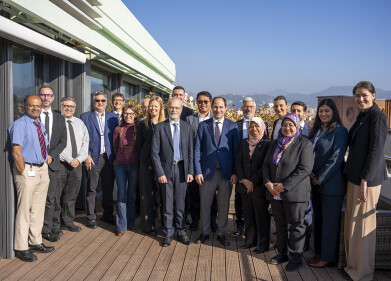Air clean up
Can smart cities share local air quality information with the public?
Feb 26 2019
In an inter-connected world, air quality is increasingly becoming another measurement made available to the public, but how reliable is the data?
Common air pollutants such as NO2 and PM2.5 mix at different rates depending on their source and local weather conditions, particularly wind speed, leaving large local variations in pollution levels. Urban air quality has traditionally been managed by authorities using a combination of large, compliance standard (reference) measurement stations and modelling based on an emissions inventory. Research has shown that increasing the number of measurement points improves the spatial resolution of urban air quality models.
Small-sensor air quality monitoring technology offers the possibility of more local measurements, and its emergence coincides with the appetite from Internet of Things (IoT) developers to map air quality across cities in real-time and communicate this information to the city inhabitants in various ways. This is leading to a growing number of smart city projects using a range of monitoring devices, but understanding the air quality information gathered and sharing it with the public can still be complicated.
Many air quality sensors that are small, cheap and have low power consumption are often very limited by the influence of fluctuating temperatures and cross-gas effects and do not produce good air quality readings. It is therefore beneficial to use a small-sensor air quality monitoring system that incorporates processing, correction and a QA/QC process in order to offer meaningful readings. Environmental authorities, including the US EPA, have developed air quality indices (AQI) and other tools to communicate local air quality to the public. These authorities are looking at how to modify that approach to provide more localised information from small sensor-sensor systems, such as air quality in a neighbourhood – or even a street – rather than a whole section of a city.
AQMesh, a small-sensor air quality monitoring system, is being used in a variety of successful smart city projects which have a range of objectives, but with a common goal of informing the public about the air quality and pollution levels in the local area where they live and work.
‘Breathe London’ was launched in February, with a sophisticated network of air quality monitors to help investigate and improve London’s toxic air. A range of fixed and mobile sensors will be used to build up a real-time, hyperlocal image of London’s air quality. The technology company Air Monitors designed and installed the network of AQMesh air quality monitoring pods, as well as the air quality analysers that were specially adapted to operate inside Google Street View cars.
In Minneapolis, Minnesota Pollution Control Agency (MPCA) has deployed 50 AQMesh pods across 50 zip code areas in order improve understanding of the small-scale differences in air pollution within urban areas.
Similarly in Newcastle, 55 AQMesh pods, supplied and supported by Air Monitors, form part of a network of over 600 sensors managed by the UK’s first Urban Observatory, which aims to provide Newcastle’s citizens with a digital view of how cities work.
These smart cities demonstrate that meaningful and reliable air quality information can be shared with the public when networks are deployed effectively and supported by air quality professionals who understand the capabilities – and limitations – of small-sensor technology and how the local environment affects air quality readings.
For more information on AQMesh projects and smart city networks please click here.
Events
Feb 05 2025 Nantes, France
Feb 16 2025 Kampala, Uganda
Feb 26 2025 Chennai, India
Feb 26 2025 Tulsa, OK, USA
WATERTECH CHINA (GUANGDONG) 2025
Mar 05 2025 Guangdong, China












